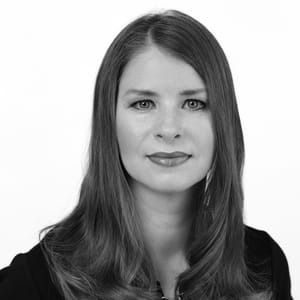The Need for Afterschool STEM Opportunities
Dr. Meghan Groome was recently asked to provide City Council testimony on the success of the Academy’s Afterschool STEM Mentoring Program.
Published October 19, 2012
By Meghan Groome, PhD

On Tuesday, October 16, 2012, Meghan Groome, PhD, was asked to provide testimony for the New York City Council on the topic of STEM (science, technology, engineering, and math) opportunities in afterschool programs. Dr. Groome runs the Academy’s Afterschool STEM Mentoring Program, which aims to create a replicable, scalable program model that can be instituted in communities near and far. Below is a transcript of Dr. Groome’s testimony.
Testimony Transcript:
Good afternoon and thank you for inviting me to testify before the Committee on Youth Services. My name is Meghan Groome and I am the director of K12 Education and Science & the City at the New York Academy of Sciences. For nearly 200 years the New York Academy of Sciences (or the Academy) has brought together extraordinary people working at the frontiers of discovery and has promoted vital links between science and society. The Academy has a history of building new scientific communities, constructing innovative connections among an extensive scientific network, and driving path-breaking initiatives for scientific, social, and economic benefit.
Since the 1940s, the Academy has made investments in K-12 (Kindergarten through 12th grade) science education, with programs like the New York City Science & Engineering Fair, capacity-building programs to support outreach in other institutions, and mentoring programs for top performing students in New York City. As a result of these investments, the Academy has increased the City’s ability to nurture top scientific talent.
In recent years, the Academy has redoubled its efforts to bring New York’s wealth of scientific resources to bear on the needs of the City’s schools, with a focus on improving science education for all students, especially those traditionally underrepresented in the STEM (science, technology, engineering, and math) fields. The New York City Science Education Initiative has a simple mission: to identify high-impact, scalable pathways for scientists to directly improve the number of children who are STEM-literate. Our theory of change relies heavily on the core competencies of the Academy – to serve as a connector between the well-resourced scientific community and the under-resourced education community (including high-need students and teachers).
The Academy’s Afterschool STEM Mentoring Program
In 2010, a group of Deans and Faculty affiliated with the City’s research and medical universities asked the Academy to create a program to provide their top young scientists with an opportunity to learn how to teach science/STEM. At the same time, The Department of Youth and Community Development (DYCD) approached the Academy to find a partnership opportunity to provide more STEM education in the OST and Beacon Programs.
Launched in Fall 2010, the Afterschool STEM Mentoring Program was designed to satisfy both requests by recruiting graduate students and postdoctoral fellows from the Academy’s Science Alliance[i] program to volunteer to teach in DYCD funded afterschool programs. When hired, I myself had a hard time understanding why a young scientist, mathematician, or engineer would take an afternoon a week to volunteer to teach 4th through 8th graders, but it becomes easier to understand when you learn that this generation of young people believe it is their obligation to serve as role models and mentors. They have grown up in a culture of service learning. They also face a tough job market where teaching, interpersonal, and mentoring skills are at a premium and can result in increased job opportunities.
Now, as we begin our 6th semester of mentors, we’ve worked with nearly 400 young scientists, 7,000 children, and delivered more than 80,000 hours of instruction in all 5 boroughs (Exhibit 1). In Fall 2011, we expanded to Newark, NJ, and recently received a $2.95 million grant from the National Science Foundation to scale this program through the State University of New York system which will serve close to 200 young scientists and 3,000 children.
The Misconceptions of What a Scientist Is
For the students in the programs, the benefits are obvious. As one of our mentors recently wrote, “Learning comes pretty easily when people enjoy what you’re asking them to learn!” Moreover, our mentors deliver high quality, inquiry-based math, science, and robotics courses while serving as role models and demonstrating to the students that scientists aren’t at all stereotypes.
For example, all of the mentors do the same activity on the first day: they ask the students to “draw a scientist”[ii]. It’s a research protocol that allows the mentors to understand that most kids hold the same misconception of a scientist; invariably the students almost all draw an older white man with crazy hair, a bowtie, and often an evil glint in his eye. It doesn’t take long after the students meet their mentors to understand that today’s scientists used to look just like them. This realization is the beginning of the development of a scientific identity. When students are again asked to draw a scientist on the last day of class, they often draw their mentors or themselves in a lab coat.
In addition to attitudinal changes, children in our program receive at least 12-15 hours of enrichment programming over the course of a semester. While this may not sound like a lot of time, consider that the average student receives 2.3 hours of science instruction a week[iii] and that many of our mentors report that they are the sole source of science in a child’s day.
Serving the Needs of Young Scientists
We are often asked why we don’t work directly with schools and the answer is that we do – we have nearly 1,400 public school teachers engaged in programming designed for them. However, through the STEM Mentoring Program we realized that we had a great opportunity to serve the need of our young scientists to learn in an environment where the children’s social, emotional, and educational well being were top priority while hewing to the hands-on, activity learning spirit of afterschool programs.
Afterschool programs typically offer smaller class sizes, freedom from state and local academic standards, reduced anxiety over tests and performance indicators, and more fluid uses of time free from the traditional school day structure. The Afterschool STEM Mentoring Program takes advantage of the existing infrastructure of OST programs, which include hundreds of community-based organizations charged with the safekeeping and, increasingly, the academic enrichment of the children in their care.
As science continues to be marginalized in formal classrooms, the role of afterschool programs is increasingly viewed as an important arena for academic enrichment[iv]. Expanding the school day through afterschool programs offers the opportunity to increase a student’s exposure to high-quality STEM education by providing three elements that lead to an individual’s persistence into a STEM career: engagement, continuity, and capacity[v].
The Importance of Engagement
While continuity and capacity are important factors, there is evidence that engagement is potentially more important than achievement or course enrollment[vi]. By infusing STEM into existing community-based afterschool programs with strong curriculum partners, the proposed program can bypass the constraints of the formal classroom structure by providing relevant, hands-on curriculum; opportunities to interact with young, diverse scientific role models; and additional content knowledge and resources[vii]. Afterschool programs reach large swaths of urban students and provide safe and structured informal learning environments that allow for creative and enriching STEM programming[viii].
As a result of the success we’ve had with the current Afterschool STEM Mentoring Program, the Academy will pilot this program with the State University of New York (SUNY) in six communities, including an expanded partnership with SUNY Downstate in Brooklyn. Additionally, we have a partnership with the Girl Scouts of the USA to scale this program through their council system.
With the generous and sustained support of our funders and the Department of Youth and Community Development, we aim to deepen our commitment to the students of New York and create a model by which any region with an abundance of scientists and students with an enthusiasm for STEM can adopt this new model for delivering high quality STEM education via afterschool programs.
Sources:
[i] www.nyas.org/sciencealliance
[ii] http://www.ecu.edu/ncspacegrant/docs/RESTEPdocs/DASTRatingRubric.pdf
[iii] http://www.csss-science.org/downloads/NAEPElemScienceData.pdf
[iv] http://afterschoolscience.org/pdf/coalition_publications/afterschool%20advantage.pdf
[v] http://www.smm.org/static/about/ecc_paper.pdf
[vi] Maltese, A. V. and Tai, R. H. (2011), Pipeline persistence: Examining the association of educational experiences with earned degrees in STEM among U.S. students. Science Education, 95: 877-907. doi: 10.1002/sce.20441
[vii] Coalition for Science After School. (2007). Science in after-school: A blueprint for Action. Retrieved from http://www.greatscienceforgirls.org/files/Science-in-Afterschool.pdf
[viii] Center for Advancement of Informal Science Education. (2010). Out of school time STEM: Building experiences, building bridges. B. Bevan, V. Michalchik, R. Bhanot, N. Rauch, J. Remold, R. Semper, & P. Shields (Eds.). San Francisco, CA: Exploratorium.
